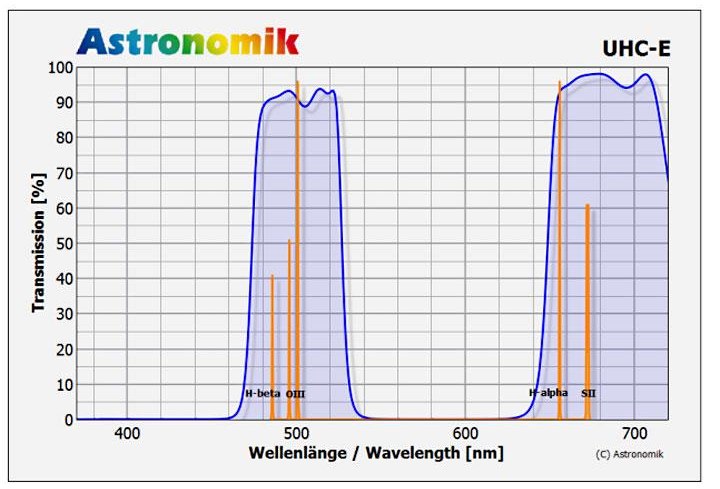
ASTRONOMIK
The Astronomik UHC-E Clip-Filter is directly inserted into the camera body and is used for nebula photography in moderately light polluted areas.
Κέρδος: 30,00€
In Stock

Ships within 24-48 hours.
Orders received until 3 p.m. are usually shipped the same day.
Astronomik UHC-E Clip-Filter for Nikon Z Cameras with Full Frame Sensor
Astronomik XL-Clip-Filter for Nikon Z Full Frame Bodies
The filters are held in place safe and secure with no stress to the high quality glass. Mounting and dismounting is easy with your fingers, without tools! No changes to the camera are necessary for using the filters!
The Challenge:
Do you own a Nikon Z digital camera for astro-imaging? Then you have surely encountered the following problems:
With the Astronomik Clip-Filter you can take care of all of these problems at once!
The patented Astronomik Clip-Filters are laser-cut on state-of-the-art machines. They can be inserted directly into the camera body within seconds. There are no changes necessary and all camera functions (focus, screen, image stabilization) remain operational!
The Clip-Filters are designed and optimized to be used with normal lenses and with telescopes as well. The Clip-Filter also acts as an outstanding dust shield, which prevents the possibility of dust settling on the sensor during long time exposure. The MC-Klarglas has no filter effect at all and is therefore actually only used as dust protection.
Due to the very tight Nikon Z bajonett the clip-filters add a minimal obstruction at the edge of the field.
The Astronomik Clip Filter is registered as a utility model at the European Patent Office.
Explanation of the filter transmission curve:

A short guide selecting the right filter for you
Lots of customers are overwhelmed by the vast number of filters offered by Astronomik. Due to that they give you a short guide how to select the right filter for your application below:
Astronomik´s normal recommendation for the "First Filter" is the CLS filter. The CLS blocks all unwanted artifical light pollution and natural airglow and gives you a dark background in your images. When using this filter you may expose much longer than without, so you will be able to pick much fainter structures and objects. The filter is designed in such a way that all objects are given in their natural colors - they would look the same if your human eye would be much more sensitive!
The CLS is the fist choice for any applications like Night-scape photography and Time Lapse movies!
Important: The standard CLS has no built-in IR-blocker. In case your camera has been modified for Astrophotography, please take the CLS-CCD which has a built-in IR-blocker!
If you have to work under a heavy light polluted sky, the UHC is a good choice too. Its transmission curve is very tight. It gives you the light from the Hß, [O III], Hα and [S II] lines in one single exposure. The reduction of light pollution is much stronger than the CLS/CLS-CCD, but the filter will work for gas nebulas only - any galaxies and open or globular clusters are filtered out! You will get "false colors" with the UHC, not natural colors like with the CLS/CLS-CCD.
The UHC-E has a more broadband light transmission. Here stars are less strongly suppressed, helpful for nebulae with star clusters.
If you want to die deeper into astrophotography, you should think about emission line filters centered on OIII, H-alpha and SII, available either with 12 nm or even 6 nm bandwidth. With these filters you can do ultra-deep images even under the worst sky you can imagine plus the full moon high up in the sky. The emission line filters isolate the light from a very tight range of wavelengths, don´t get any color information. If you want to create color images (false color like images from the HST), you will need all three filters to mix the three channels into a final color image.
When using cameras without IR cut filter in astronomy, we recommend the UV-IR block filters of the L-1, L-2 and L-3 series to correct chromatic aberrations when using refractive optics (camera lenses, refractors). Depending on the color correction of your scope you may use a wider spectral window for the Luminance data. The L1 filter has the widest spectral window, the L2 is about the same as our current L-Filter and the L3 is much narrower.
If you use an optical system that is more or less free of chromatic aberration you should get an L1 filter for your setup. For general use the L2 filter is well suited to most optical systems with a corrector, flattener or reducer in the optical train while the L3 filter is designed for users of refractors with a less-than-perfect color correction.
As protection against dust in cameras without IR cut filter, the MC clear glass filter is suitable. It blocks neither visible light nor UV or IR, but is parfocal with the other clip filters for Nikon Z full frame cameras.
Especially made for planetary imaging are the ProPlanet IR pass filters. The IR light transmitted by them is less sensitive to air turbulence ("seeing"), which makes the images sharper, with increasingly longer wavelengths being increasingly less affected.